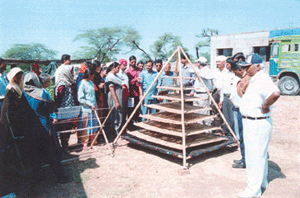 |
|
 |
| |
|
Schemes |
|
S
& T Application for Rural Development
(STARD) |
|
STARD aims at facilitating development of
promising S & T based field groups and innovative
technologies related to rural development. It also
has a unique program to support selected voluntary
agencies with a proven track record of innovative
work in development and application of technologies
for rural areas.
OBJECTIVES
-
To
strengthen the existing institutions, field
groups, etc., involved in research, development,
design, adaptation and application of innovative
S&T solutions for rural development by providing
long-term support for core personnel;
-
To
catalyze research, development and adaptation
of technology by supporting time-bound development
efforts aimed at measurable milestones;
-
To
motivate scientists and technologists for applying
their expertise to finding solutions for problems
in the rural areas; and
-
To
take up all such activities which are conducive
to the attainment of the above objectives.

Solar Dryer made of bamboo
(Developed by ARTI under DST funding)
PRIORITY
AREAS
The
following priority areas have been identified:
-
Water
Management: Exploration, harvesting and
purification of water in rural areas with
particular emphasis on land, water and cover
management;
-
Construction:
Use of local resources, upgrading local
skills and techniques for constructing affordable
houses conforming to a minimum acceptable
comfort level inclusive of improved domestic
drainage and waste disposal;
-
Agriculture,
Animal Husbandry and Aquaculture: Effective
use of inputs, integrated farming systems,
post-harvest technology including low-cost
storage, preservation and processing;
-
Engineering
Services: Design, development and up-gradation
of farm and non farm tools and machinery;
-
Rural
industries: R&D projects in the area
of rural process industries;
-
Establishment
of Rural Technology Parks as technology
resource centres for technology back-up/support
system in both farm and non-farm sector;
-
Innovative
project proposals related to above mentioned
areas for Technological Interventions in
Mountain and hilly Eco-systems
(TIME).
|
| |
<% Set pageCount = Server.CreateObject("MSWC.PageCounter") %>
<% pageCount.PageHit %>
Visitor
No
|
|
 |
|
 |
| |
|
|
|
|
|
| |
|
this post
 |
|
Announcements |
|
|
| |
| Technology
Models for
Rural Application |
| |
|
|
| |
|